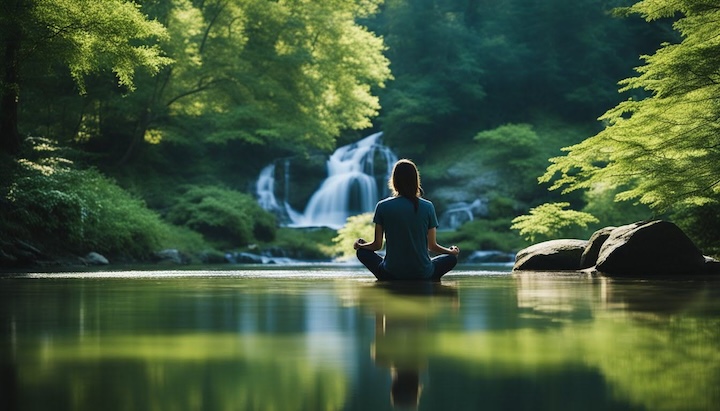Grounding Techniques for Anxiety: 17 Most Effective Coping Strategies & Exercises to Find Calm

Feeling overwhelmed by anxiety is all too common, but there are effective ways to manage it. Grounding techniques can provide immediate relief by helping you reconnect with the present moment. These strategies range from simple breathing exercises to sensory and cognitive methods designed to reduce stress and promote relaxation.
When anxiety strikes, your mind may race, and your body might feel tense. Grounding techniques can interrupt this cycle, bringing your focus back to the here and now. Whether at home, at work, or in public, these practical tools can be integrated into your daily routine to enhance your mental health.
Finding the right grounding technique for you can make a significant difference. Experimenting with various methods, such as physical movement or sensory awareness, will allow you to discover what works best for you.
Incorporating these techniques into your life can act as a powerful coping strategy and even complement professional therapy if needed.
Key Takeaways
- Grounding techniques help reconnect you with the present moment.
- These methods can reduce stress and enhance mental health.
- Experiment with different techniques to find what works best for you.
How Anxiety Affects the Mind and Body
Anxiety triggers the fight-or-flight response, releasing hormones like adrenaline and cortisol. These hormones prepare your body to respond to perceived threats.
You may experience physical symptoms such as increased heart rate, sweating, and muscle tension. Breathing can become rapid and shallow.
Cognitive effects are also noticeable. You might have difficulty concentrating, feel restless, or have racing thoughts. Anxiety can lead to persistent worrying. Emotionally, anxiety often makes you feel overwhelmed or fearful. These feelings can disrupt your daily routine and affect your interactions with others.
Long-term anxiety can have health implications. It can weaken your immune system and increase the risk of chronic conditions like hypertension. Sleep disturbances are common.
Anxiety can make it hard for you to fall asleep or stay asleep, leading to fatigue and reduced daily functioning. Understanding these effects can help you manage your anxiety better. Recognizing the signs allows you to implement effective grounding techniques.
Anxiety impacts your digestive system, too. You might experience stomachaches, nausea, or changes in appetite. These symptoms are part of the body’s stress response.
Behavioral changes can also occur. You may avoid situations that make you anxious, which can limit your activities and social interactions. This avoidance can sometimes worsen anxiety over time.
What Are Grounding Techniques

Grounding techniques are strategies designed to help you stay present and anchored in the current moment. They can be especially helpful for managing anxiety and stress.
The Goals of Grounding
The primary goal is to bring focus to the here and now, allowing you to manage overwhelming emotions.
Grounding techniques aim to distract you from distressing thoughts by shifting your attention to your surroundings through your senses. For example, you might concentrate on the texture of an object, the sounds around you, or specific physical movements.
This redirection reduces anxiety by breaking repetitive negative thought patterns. Additionally, these techniques help you build a sense of calm and control, making it easier to handle stressful situations more effectively.
Fundamentals of Grounding Techniques
Grounding techniques help manage anxiety by bringing your focus to the present moment. These techniques redirect your attention from anxious thoughts to the here and now.
Five-Senses Method: List five things you can see, four things you can touch, three things you can hear, two things you can smell, and one thing you can taste. This helps you immerse yourself in your surroundings.
Deep Breathing: Inhale deeply through your nose, hold for a few seconds, and exhale slowly through your mouth. This will promote relaxation and reduce anxiety symptoms.
Mental Exercises: Recite a favorite poem or count backward from 100. Engaging your mind in a simple task can help you shift focus away from anxiety.
Physical Techniques: Ground your feet on the floor, feel the connection, and notice the pressure. This provides a sense of stability and focus.
Using visualization, imagine yourself in a calm place or picture your anxiety melting away. Visualization leverages your mind’s power to create a serene mental space.
Grounding can also involve physical activity. Stretching, walking, or even simple exercises like squeezing a stress ball can redirect anxious energy and promote relaxation.
Journaling is another effective method. Writing your thoughts down consolidates them and provides clarity, making it easier to manage anxiety. Each technique offers a practical coping strategy, ensuring you have multiple options to address your anxiety effectively.
Breathing Exercises for Grounding
Breathing exercises can be a powerful tool for reducing anxiety and grounding yourself in the present moment. The following techniques focus on diaphragmatic and rhythmic breathing to achieve calm and relaxation.
Diaphragmatic Breathing
Diaphragmatic breathing involves deep breaths that fully engage the diaphragm. This technique encourages more efficient oxygen exchange, which helps calm your nervous system and reduce stress.
To perform diaphragmatic breathing:
- Find a comfortable position. Sit or lie down with your head supported.
- Place one hand on your chest and another on your abdomen.
- Inhale deeply through your nose, allowing your abdomen to rise against your hand.
- Exhale slowly through your mouth, feeling your abdomen fall.
By focusing on the rise and fall of your abdomen, you direct your attention away from anxious thoughts, grounding you in the present.
Rhythmic Breathing
Rhythmic breathing is a technique where you set a consistent breathing pattern. This regularity can help stabilize your thoughts and create a feeling of calm.
To practice rhythmic breathing:
- Sit comfortably with your back straight.
- Close your eyes and inhale deeply through your nose for a count of four.
- Hold your breath for a count of four.
- Exhale slowly through your mouth for a count of four.
Repeat this cycle for several minutes. The consistent rhythm of your breathing steadies your mind, helping to alleviate stress and anxiety. Keep your focus on maintaining the rhythm, which can anchor the present moment.
Sensory Awareness Techniques

Being present in the moment can be a powerful way to manage anxiety. Sensory awareness techniques help you focus on immediate sensations, keeping your mind grounded and reducing stress.
5-4-3-2-1 Technique
The 5-4-3-2-1 technique effectively engages your senses and draws your attention to the present. Start by identifying five things you can see around you. Next, notice four things you can feel. Follow with three sounds you can hear.
Then, identify two things you can smell. Finally, acknowledge one thing you can taste. This technique helps redirect your focus away from anxious thoughts to your immediate surroundings.
Engaging the Five Senses
Engaging all five senses can help anchor your mind in the moment. Sight, sound, smell, taste, and touch each play a role. For sight, observe the details in your environment, noticing colors, shapes, and patterns.
For sound, listen to ambient noises, whether it’s birds chirping or household sounds. Smell can involve taking a deep breath of fresh air or a scented candle. Taste might involve slowly savoring a piece of candy.
Lastly, touch can be as simple as feeling the texture of your clothing or a nearby object. These practices immerse you in the present and enhance mindfulness.
Physical Movements and Exercises
Engaging in physical movements and exercises can significantly help alleviate anxiety. These methods focus on activities such as yoga, stretching, walking, and connecting with nature.
Yoga and Stretching
Yoga involves various poses, known as asanas, which can help reduce anxiety by promoting relaxation and mindfulness. Practicing yoga regularly can enhance the connection between your mind and body, resulting in a calm mental state.
Stretching complements yoga by loosening tight muscles, which can accumulate tension from chronic anxiety. Simple stretches, like reaching for your toes or side bends, can improve flexibility and circulation. Including breath control techniques, such as Pranayama, can deepen the effects of relaxation.
Walking and Nature Engagement
Walking offers a combination of mild exercise and rhythmic motion that can soothe an anxious mind. A 20-minute walk can elevate your mood as it stimulates endorphin production. Regular walking routines can improve your fitness, contributing to your overall well-being.
Engaging with nature while walking can amplify these benefits. Like walking through parks or trails, nature engagement has been shown to lower cortisol levels, reducing stress.
Observing natural elements such as trees, water, and wildlife can make the experience more immersive and therapeutic. Regular nature walks blend exercise with the calming effects of the outdoors, offering a holistic approach to stress relief.
Cognitive Grounding Methods

Cognitive grounding methods provide practical tools for managing anxiety. They focus on using mental exercises like visualizations and affirmations to center one’s thoughts and enhance mental health.
Visualization Techniques
Visualization is a cognitive method that involves creating mental images to achieve a sense of calm. Picture yourself in a peaceful setting, such as a quiet beach or a serene forest. Focus on the details: the sound of waves, the smell of pine trees, or the sun’s warmth.
Consider combining visualization with deep breathing to increase its effectiveness. As you breathe in, imagine yourself drawing in tranquility; as you breathe out, envision releasing tension. Visualization can redirect your focus from anxiety to a more controlled mental state, enhancing your overall well-being.
Positive Affirmations and Self-Talk
Positive affirmations and self-talk involve repeating encouraging phrases to yourself to counteract anxiety. Examples include “I am in control,” “I am safe,” or “I can handle this.” These statements can help shift your focus from negative thoughts to empowering ones.
Consistent practice of affirmations, especially during moments of increased anxiety, can reinforce a positive mindset. Writing down affirmations and placing them where you can see them daily, like on your mirror or desk, can serve as constant reminders to support your mental health.
Self-talk techniques help you build resilience against stress by transforming your cognitive patterns into more supportive ones.
Routine Integration for Lasting Benefit
Incorporating grounding techniques into your daily routine can significantly enhance your ability to manage anxiety. Creating and maintaining consistent habits can cultivate a more stable and calm mental state.
Creating a Grounding Routine
To create a grounding routine, begin by identifying specific grounding techniques that resonate with you. These might include deep breathing exercises, mindfulness practices, or physical grounding, like pressing your feet into the floor.
Commit to practicing these techniques daily. Structure them around existing habits, such as morning meditation or evening walks, to help integrate them smoothly into your routine.
Set reminders on your phone or calendar to ensure consistency. Gradually, these practices will become part of your daily self-care regimen.
Start small and build gradually. For example, allocate five minutes for a quick breathing exercise in the morning. As it becomes habitual, you can extend the time. This approach makes it easier to sustain long-term.
Incorporating Grounding Into Daily Life
Engage in grounding exercises throughout your day, not just during dedicated times. For example, during stressful moments at work, use quick techniques like counting backward from 100 or focusing on the sensation of an object in your hand.
Integrate grounding into daily activities. When walking, pay attention to your steps and the sensation of the ground. While eating, focus on the taste and texture of your food.
Develop mindful habits. Be present in your routine activities, whether it’s brushing your teeth or washing dishes. This mindfulness can serve as spontaneous grounding moments, helping you stay connected to the present and manage anxiety effectively.
Keep a journal to track your progress and note which techniques work best for you. You can create a resilient and supportive structure for managing anxiety by embedding grounding practices into your daily life.
Support and Professional Guidance
Accessing support and professional guidance is essential for managing anxiety effectively. Knowing when to seek professional help and where to find quality resources can make a big difference.
When to Seek Professional Help
Consider seeking professional help if your anxiety is interfering with daily life. This can include difficulty concentrating, persistent worry, or physical symptoms like rapid heartbeat.
A mental health professional can offer therapy options such as Cognitive Behavioral Therapy (CBT), which is highly effective for anxiety. It’s essential to consult a professional if you feel overwhelmed. They can guide you through personalized strategies and coping mechanisms tailored to your needs.
Reaching out to a therapist could provide the necessary support and tools to manage anxiety more effectively. Don’t hesitate to seek professional assistance if you notice persistent or worsening symptoms.
Resources and Further Reading
Several resources can provide additional support and information. Websites like the National Institute of Mental Health (NIMH) and the Anxiety and Depression Association of America (ADAA) offer reputable articles and information.
Books such as Feeling Good by David D. Burns and The Anxiety and Phobia Workbook by Edmund J. Bourne also provide valuable insights and exercises.
Many online platforms offer articles and guidance on anxiety management. Engaging in forums or support groups can also be beneficial. Utilize these resources to educate yourself and find the best strategies for your situation.
Frequently Asked Questions
Grounding techniques offer practical tools to manage anxiety and panic attacks, utilizing sensory and cognitive methods to bring you back to the present moment.
What are the most effective grounding techniques for panic attacks?
Effective techniques include deep breathing, focusing on your surroundings, and the 5-4-3-2-1 method. These help to shift your focus away from panic symptoms.
How does the 5-4-3-2-1 grounding technique work for managing anxiety?
This method involves identifying five things you see, four things you feel, three things you hear, two things you smell, and one thing you taste. It helps redirect your thoughts to the present.
Can grounding techniques be used to help with dissociation?
Yes, grounding techniques can help with dissociation. They work by reconnecting you with your physical environment through sensory awareness.
What is the role of the 5 senses in grounding exercises for anxiety?
The 5 senses engage you directly with your surroundings, helping to anchor you in the present moment and reduce anxiety.
How can the 3-3-3 rule be applied as a grounding method for anxiety relief?
The 3-3-3 rule involves naming three things you see, three sounds you hear, and moving three parts of your body. This aids in focusing your mind and alleviating anxiety.
Are there any specific grounding exercises recommended by therapists for anxiety?
Therapists often recommend guided imagery, progressive muscle relaxation, and mindfulness activities. These exercises help to calm your mind and center your thoughts.






